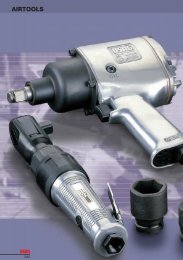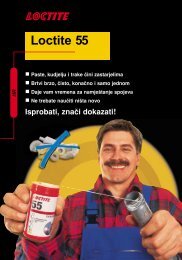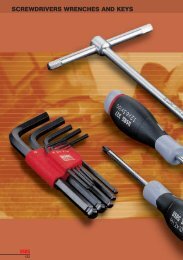Industrial seal self study guide - SKF.com
Industrial seal self study guide - SKF.com
Industrial seal self study guide - SKF.com
You also want an ePaper? Increase the reach of your titles
YUMPU automatically turns print PDFs into web optimized ePapers that Google loves.
Glossary of Seal Terms (cont...)<br />
Shell, Outer (Case, Outer) – The outer,<br />
cup-shaped, rigid structure of the lip assembly.<br />
Acts as a protective cover for the head of the<br />
<strong>seal</strong>ing element.<br />
Silicone – A type of elastomer having a basic<br />
polymer of dimethyl polysilozane, with various<br />
attached vinyl or pheyl groups. (ASTM class VMQ)<br />
Single Lip – Seal element utilizing one contact<br />
point, with or without springs.<br />
Sinusoidal – Describing an alternative wave form<br />
centered on a fixed line.<br />
Sirvene – <strong>SKF</strong>’s tradename for synthetic rubber.<br />
Slinger – A washer-like device used for imparting<br />
radial momentum to a liquid order too keep the<br />
latter away from the <strong>seal</strong>ing interface. Often<br />
incorporated into a wear sleeve.<br />
Small Diameter Seals – Seals that fit shafts<br />
ranging from .110” to 12.5” (2.8mm to 317.5mm)<br />
in diameter.<br />
Solid Seals – Continuous <strong>seal</strong>s without a split.<br />
Spark Out – When the grinding wheel is allowed<br />
to run until there are no more sparks flying from<br />
the wheel.<br />
Speedi-Sleeve – The Speedi-Sleeve is a highly<br />
engineered, precision part of the finest 300 series<br />
stainless steel. Its surface is factory finished to<br />
10-20 micro inch Ra (.25-.50 micro meter), with<br />
no machine lead, and requires no expensive preparation<br />
or machining before installation.<br />
Spindle – Slots of positive or negative alternating<br />
shapes used to connect two elements, one usually<br />
drives the other.<br />
Split Seal – A <strong>seal</strong> which has its primary <strong>seal</strong>ing<br />
element split, approximately parallel with the shaft<br />
axial centerline. Typically used where conventional<br />
installation methods are impractical.<br />
Spring-Loaded – The design of most oil <strong>seal</strong>s in<br />
which a spring is incorporated to provide a uniform<br />
load at the <strong>seal</strong> contact line-shaft surface junction.<br />
Spring-Lock – A <strong>seal</strong>ing lip design that extends<br />
over and surrounds most of the garter spring’s<br />
diameter.<br />
Spring-Kover – A flexible, rubber like covering that<br />
totally enclosed the garter spring.<br />
Spring Position – The axial distance between the<br />
“<strong>seal</strong> contact line” and the centerline of the spring<br />
groove of a radial lip <strong>seal</strong>; <strong>com</strong>monly referred to as<br />
the “R” value.<br />
Static Seal – Seal without a dynamic contact<br />
surface. Example is a refrigerator gasket.<br />
Surface, Contact – The portion of the <strong>seal</strong> lip<br />
which circumferentially contacts the shaft to form<br />
the <strong>seal</strong>-shaft interface.<br />
Surface Honing – A cross hatching pattern on the<br />
shaft causing a grooving which tends to act as a<br />
lead, allowing lubricant to escape under the <strong>seal</strong> lip.<br />
Synthetics – The most popular and versatile lip<br />
<strong>seal</strong>ing element in use today. These include<br />
nitriles, polyacrylates, silicones and fluoroelastomers.<br />
Synthetic Rubber – Synthetic elastomers made by<br />
polymerization of one or more monomers.<br />
STBM – Shaft-to-bore-misalignment. The amount<br />
by which the shaft is off center, with respect to the<br />
bore’s center.<br />
Talysurf – Device used to measure shaft surface<br />
finish.<br />
Test, Accelerated Life – Any set of test conditions<br />
designed to reproduce in a short time the effects<br />
obtained under service conditions.<br />
Test, Bench – A laboratory test procedure in<br />
which the functional operating conditions are<br />
approximated, but the equipment is conventional<br />
laboratory equipment and not necessarily identical<br />
with that in which the product will be used.<br />
92







